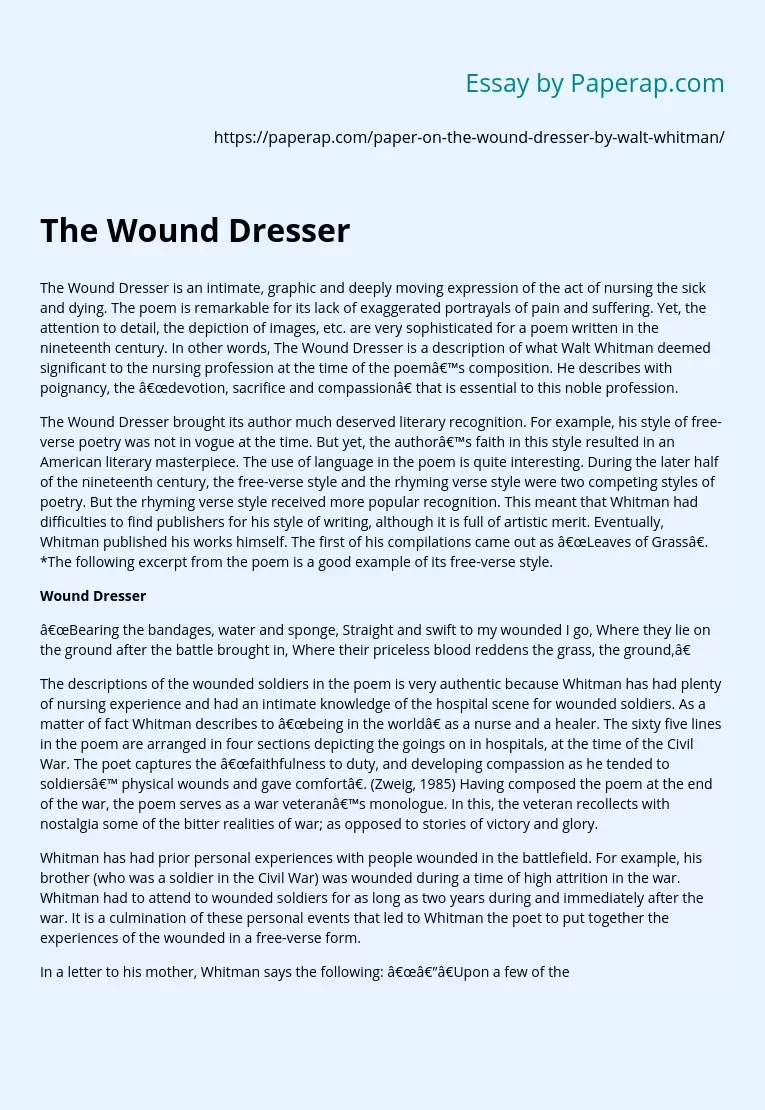The Wound Dresser
The Wound Dresser is an intimate, graphic and deeply moving expression of the act of nursing the sick and dying. The poem is remarkable for its lack of exaggerated portrayals of pain and suffering. Yet, the attention to detail, the depiction of images, etc. are very sophisticated for a poem written in the nineteenth century. In other words, The Wound Dresser is a description of what Walt Whitman deemed significant to the nursing profession at the time of the poem’s composition.
He describes with poignancy, the “devotion, sacrifice and compassion” that is essential to this noble profession.
The Wound Dresser brought its author much deserved literary recognition. For example, his style of free-verse poetry was not in vogue at the time. But yet, the author’s faith in this style resulted in an American literary masterpiece. The use of language in the poem is quite interesting. During the later half of the nineteenth century, the free-verse style and the rhyming verse style were two competing styles of poetry.
But the rhyming verse style received more popular recognition. This meant that Whitman had difficulties to find publishers for his style of writing, although it is full of artistic merit. Eventually, Whitman published his works himself. The first of his compilations came out as “Leaves of Grass”. *The following excerpt from the poem is a good example of its free-verse style.
Wound Dresser
“Bearing the bandages, water and sponge, Straight and swift to my wounded I go, Where they lie on the ground after the battle brought in, Where their priceless blood reddens the grass, the ground,”
The descriptions of the wounded soldiers in the poem is very authentic because Whitman has had plenty of nursing experience and had an intimate knowledge of the hospital scene for wounded soldiers.
As a matter of fact Whitman describes to “being in the world” as a nurse and a healer. The sixty five lines in the poem are arranged in four sections depicting the goings on in hospitals, at the time of the Civil War. The poet captures the “faithfulness to duty, and developing compassion as he tended to soldiers’ physical wounds and gave comfort”. (Zweig, 1985) Having composed the poem at the end of the war, the poem serves as a war veteran’s monologue. In this, the veteran recollects with nostalgia some of the bitter realities of war; as opposed to stories of victory and glory.
Whitman has had prior personal experiences with people wounded in the battlefield. For example, his brother (who was a soldier in the Civil War) was wounded during a time of high attrition in the war. Whitman had to attend to wounded soldiers for as long as two years during and immediately after the war. It is a culmination of these personal events that led to Whitman the poet to put together the experiences of the wounded in a free-verse form.
In a letter to his mother, Whitman says the following: “—”Upon a few of these hospitals I have been almost daily calling as a missionary, on my own account, for the sustenance and consolation of some of the most needy cases of sick and dying men…One has much to learn to do good in these places…Here,…I like to flourish…I can testify that friendship has literally cured a fever, and the medicine of daily affection, a bad wound…” (Bucke, 1949)
The poem reflects how Whitman genuinely believed about the realities of war. Hence, “The Wound Dresser” is a memory poem about how the soldiers during the Civil War period were treated not as per their rank, seniority or bravery but by the severity of their wounds. Whitman presents this fact in contrast to the civil society of the times where one’s socio-economic background, ethnicity and race precede all consideration of “needs”. The following concluding stanza from the poem captures its essence.
“I sit by the restless all the dark night, some are so young, Some suffer so much, I recall the experience sweet and sad, (Many a soldier’s loving arms about his neck have cross’d and rested, Many a soldier’s kiss dwells on these bearded lips.)”
References:
RM Bucke, The Wound Dresser: Letters Written to His Mother from the Hospitals in Washington During the Civil …, W Whitman, 1949, Bodley Press, New York.
P Zweig, A review of The wound-dresser, Walt Whitman, 1985.
The Wound Dresser. (2019, Dec 05). Retrieved from https://paperap.com/paper-on-the-wound-dresser-by-walt-whitman/

